Taig-Microproto VS Bipolar Comparison
The Taig/Mircroproto controller does a good job, but is only a unipolar driver so does not put the most power into the stepper motor. Bipolar drivers such as the Gecho, and over here the Chinese and our own drivers in theory put twice as much power in. The closed loop system provided by Taig/Microproto does something to address the difference, but at the expense of a possible lag in the position buy up to 200 steps. The closed loop system CAN produce a faster unloaded speed, but when cutter load is introduced, it needs to be 'throttled back to something a little slower. And when pushing speed, the closed loop 'delay' will result in rounded corners as a change in axis will start before the controller has caught up.
Open loop performance from the Taig controller should be a good 25IPM, while a bipolar driver will achieve 50IPM when running with 48V and 2.5 or 3Amps. Drop the voltage back to the 24V of the cheaper bipolar drivers and 30IPM is more realistic. Although on all of the drivers, the machine setup will affect reliable top end speed. Tighten things up for the best backlash performance, and the Taig controller will max out at about 15IPM, while the bipolar drivers will be safe at 30 to 40IPM. I run the 3Amp driver controller at 900mm/min (35IPM) reliably, and 1200mm/min (47IPM) with a little care, and slower cutting speeds.
The closed loop Taig will run reliably at 60IPM, and can achieve the 100IPM quoted in free air, but realistically 50IPM is safer, provided that you slow things down further when actually cutting. I run the closed loop machine at 1500mm/min - just under 60IPM, but occasionally have to rework boxes when a get a 'stall'. 1200mm/min gives a much cleaner result on the corners of square cutouts, and slowing down to 900mm/min is best for fine detail work ... the same as the open loop bipolar driver.
The other thing that comes into the equation is microstepping, since the Taig controller is only half stepping, so is restricted in resolution as has been mentioned previously. Bipolar drivers are capable of microstepping, although I personally would not bother with the 10 step setting of the Gecho. Running Mach3 at 25Khz limits the top stepping speed, and at 1/8 stepping you may hit the maximum speed of Mach3 before you hit that max speed of the hardware. 1/4 stepping gives a nice compromise on speed without needing to switch to a higher kernel setting.
Tony Jeffree has done a nice comparison on the stepper motor differences here








